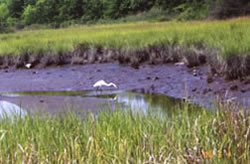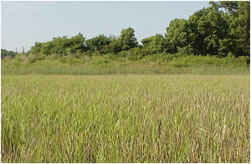Ecological Consequences of Habitat Modification:
My undergraduate work at the College of William and Mary with my advisor Dan Cristol focused on whether created saltmarshes effectively replace natural saltmarshes that have been destroyed for development. During my first year on this project I was responsible for conducting vegetation transects and showed that created wetlands are primarily monculture stands of Spartina alterniflora and therefore the diversity of plant species is much lower in created wetlands than the natural wetlands they are meant to replace. This work was done as part of David Desrochers' masters thesis where he showed that avian communities differed between the two wetland types as well, with created wetlands having lower abundance and richness of breeding birds. You can read the publication that resulted from this work here: [pdf].
My second year on this project and my honors thesis involved a productivity study of red-winged blackbirds (Agelaius phoeniceus) in these same created and natural saltmarshes. While red-winged blackbirds are not of conservation concern in this habitat, they are ubiquitous and can serve as a model system for studying differences in reproductive output in these two types of wetland. In southeastern Virginia, wetlands are replaced at the same rate as they are destroyed, a requirement of the Clean Water Act. I developed a mathematical model that explored the consequences of replacing habitat of one quality with habitat of a lower quality (e.g., created saltmarshes had lower productivity due to higher egg predation). I showed that if the created habitat is a sink there is a "point of no return" where the population cannot be maintained at the current abundance if more natural habitat is destroyed. Also a one-for-one replacement strategy does not work if the created habitat is not of the same quality as the habitat being destroyed [pdf].

Natural marsh. Notice the variation in topography and the multiple species of plants.

Created marsh. A 'wet soccer field'.